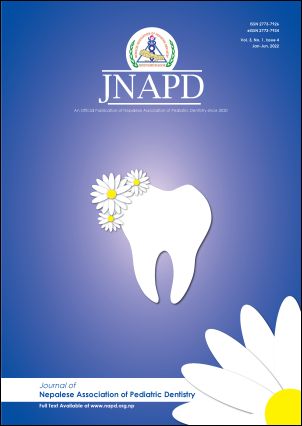Knowledge, Attitude and Practice on Dental Sedation among Pediatric Dentists in Nepal
DOI:
https://doi.org/10.3126/jnapd.v3i1.50060Keywords:
Anesthesia, children, dental sedation, Nepal, pediatric dentistAbstract
Introduction: Recent years have evidenced an increase in the use of sedation in children for their dental treatment, with a wide variation in the global practice among the pediatric dentists.
Objective: The purpose of this study was to assess the knowledge, attitude, and practice on dental sedation amongst the pediatric dentists of Nepal. Methods: This was an online-based questionnaire survey conducted from May to June 2021 among 29 pediatric dentists practicing in Nepal using a census sampling. Data were analyzed and presented in percentage, mean, and standard deviation along with charts and tabular forms.
Results: Majority of the respondents 26 (89.7%) had adequate knowledge and 22 (76%) had adequate practice on sedation with a total positive mindset. The mean (Mean ± Standard Deviation) scores for knowledge, attitude, and practice were 3.759 ± 0.9124, 6.897 ± 1.1131, and 3.414 ± 1.3501, respectively. Nineteen (65.5%) of them practiced dental sedation that included general anesthesia, oral, inhalational, intravenous and intra-nasal routes.
Conclusions: The study showed satisfactory knowledge, attitude, and practice of dental sedation among the pediatric dentists in Nepal. There was lack of training on emergency skills and formal sedation courses other than for inhalational sedation among the participants, and these were cited as the major barriers to their practice along with lack of adequate facilities. Hence, regular conduction of sedation trainings and life support skills targeting the pediatric dentists in Nepal is deemed essential.
Downloads
Downloads
Published
How to Cite
Issue
Section
License

This work is licensed under a Creative Commons Attribution 4.0 International License.
This license enables reusers to distribute, remix, adapt, and build upon the material in any medium or format, so long as attribution is given to the creator. The license allows for commercial use.




